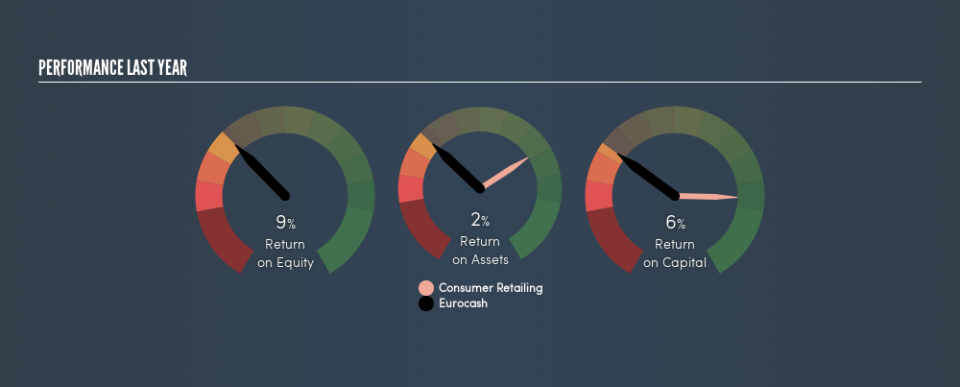Should You Care About Eurocash S.A.’s (WSE:EUR) Investment Potential?

Want to participate in a short research study? Help shape the future of investing tools and you could win a $250 gift card!
Today we are going to look at Eurocash S.A. (WSE:EUR) to see whether it might be an attractive investment prospect. Specifically, we'll consider its Return On Capital Employed (ROCE), since that will give us an insight into how efficiently the business can generate profits from the capital it requires.
Firstly, we'll go over how we calculate ROCE. Next, we'll compare it to others in its industry. And finally, we'll look at how its current liabilities are impacting its ROCE.
Understanding Return On Capital Employed (ROCE)
ROCE measures the 'return' (pre-tax profit) a company generates from capital employed in its business. In general, businesses with a higher ROCE are usually better quality. Ultimately, it is a useful but imperfect metric. Renowned investment researcher Michael Mauboussin has suggested that a high ROCE can indicate that 'one dollar invested in the company generates value of more than one dollar'.
So, How Do We Calculate ROCE?
The formula for calculating the return on capital employed is:
Return on Capital Employed = Earnings Before Interest and Tax (EBIT) ÷ (Total Assets - Current Liabilities)
Or for Eurocash:
0.056 = zł146m ÷ (zł8.2b - zł5.5b) (Based on the trailing twelve months to March 2019.)
So, Eurocash has an ROCE of 5.6%.
See our latest analysis for Eurocash
Does Eurocash Have A Good ROCE?
ROCE is commonly used for comparing the performance of similar businesses. Using our data, Eurocash's ROCE appears to be significantly below the 7.3% average in the Consumer Retailing industry. This performance could be negative if sustained, as it suggests the business may underperform its industry. Regardless of how Eurocash stacks up against its industry, its ROCE in absolute terms is quite low (especially compared to a bank account). Readers may wish to look for more rewarding investments.
Eurocash's current ROCE of 5.6% is lower than its ROCE in the past, which was 23%, 3 years ago. So investors might consider if it has had issues recently.
It is important to remember that ROCE shows past performance, and is not necessarily predictive. ROCE can be misleading for companies in cyclical industries, with returns looking impressive during the boom times, but very weak during the busts. This is because ROCE only looks at one year, instead of considering returns across a whole cycle. Since the future is so important for investors, you should check out our free report on analyst forecasts for Eurocash.
What Are Current Liabilities, And How Do They Affect Eurocash's ROCE?
Current liabilities include invoices, such as supplier payments, short-term debt, or a tax bill, that need to be paid within 12 months. Due to the way ROCE is calculated, a high level of current liabilities makes a company look as though it has less capital employed, and thus can (sometimes unfairly) boost the ROCE. To counteract this, we check if a company has high current liabilities, relative to its total assets.
Eurocash has total liabilities of zł5.5b and total assets of zł8.2b. As a result, its current liabilities are equal to approximately 68% of its total assets. This is a fairly high level of current liabilities, boosting Eurocash's ROCE.
What We Can Learn From Eurocash's ROCE
Unfortunately, its ROCE is also pretty low, so we are cautious about the stock. Of course, you might also be able to find a better stock than Eurocash. So you may wish to see this free collection of other companies that have grown earnings strongly.
For those who like to find winning investments this free list of growing companies with recent insider purchasing, could be just the ticket.
We aim to bring you long-term focused research analysis driven by fundamental data. Note that our analysis may not factor in the latest price-sensitive company announcements or qualitative material.
If you spot an error that warrants correction, please contact the editor at editorial-team@simplywallst.com. This article by Simply Wall St is general in nature. It does not constitute a recommendation to buy or sell any stock, and does not take account of your objectives, or your financial situation. Simply Wall St has no position in the stocks mentioned. Thank you for reading.


